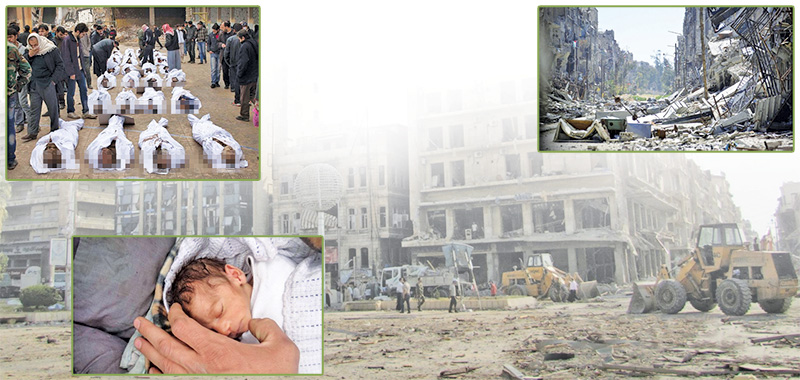Bigotry: The Dark Danger
A Helping Hand for Refugees

DOWNLOAD THE BOOK
CHAPTERS OF THE BOOK
- Introduction
- Supporting refugees is the behavior that will be most pleasing to God
- Adnan Oktar's remarks concerning refugees on A9 TV
- Events in Myanmar are crime against humanity
- A cry for help to the U.N. from Rohingya of Myanmar
- What if you were living in a refugee camp?
- The crime against humanity in Yarmouk must be ended as a matter of urgency!
- Behind the persecution in Myanmar
- How does it feel to be a Rohingya?
- One of the dozens of problems facing Yemen is immigration
- Refugees: Stopping the Madness
- The safety of our Syrian refugee brothers is entrusted to the hospitable Turkish people
- Buffer Zone: A Safe Haven for the Syrians
- A secure zone must be established at once on the Turkish-Syrian border
- The conundrum of Libya's refugees and migrants
- Drowning migrants is a blot on humanity
- Are the boat people a burden for Thailand?
- Deafening silence over Rohingya issue
- What can European countries do against the tide of Migration?
- The Rohingya Muslims are being exiled in their own lands
- Syrian refugees in the 4th year of the crisis
- Syria: The downward spiral of desolation
- Illegal immigrants: Only a statistic in Europe
- Syria’s human tragedy
- Yarmouk cries for help
- The world refugee problem can be solved with love
- Adnan Oktar's Remarks Concerning Refugees on A9 TV
- Europe must step up for humanity
- Nobody to wipe Rohingyas’ tears
- Asylum seekers: A problem of humanity or security?
- It is no economic loss to help Syrian refugees
- A heart for helping refugees
- When conscience fails, children suffer
- Events of global shame
- Will Europe pass the refugee test?
- Condemning refugees to death
- The European refugee crisis: Only if there were some empathy
- The priority in Libya must be to establish love and affection between the blocs: Consensus will then come naturally
- Refugees with no great expectation
- Walls cannot be a solution to security issues
- Refugees not a threat, but an important asset for Europe
- What will election victory bring to the people of Rohingya?
- Humans have rights on paper, but apparently not in real life
- EU, Turkey find silver lining
- Refugees are the victims of the Paris attacks, not its perpetrators
- Being leaderless is the reason behind the oppression Muslims suffer
- The EU is in danger of taking Turkey for granted
- Conclusion
< <
24 / total: 48
Syria’s human tragedyNew Straits Times, The Daily Mail & Indian Muslim Observer - 9 April 2015
The Middle East, the scene of war and slaughter for hundreds of years, is the bloodiest region in the world. Instead of bringing with them peace and stability, the revolutionary movements that began with the hope of ushering in a 'Spring' actually led to greater bloodshed and violence and casting a pall of uncertainty over the region's future. The heaviest toll was without doubt paid in Syria. Syria has been home to numerous civilizations throughout the ages. Today it is divided, its society has been torn apart and it is on the brink of collapse. Suffering dominates everywhere and the civil war, which has now entered its fifth year, has transformed into a full-blown regional war. And regrettably, it is once again the innocent Syrian people who suffer the most. The sufferings of the Syrians struggling to survive in the fighting and bloodshed between fragmented groups as they seek freedom and democracy are ineffable. In the same way that they are deprived of a free democratic life, they are also losing their lives, their children, their homes and their belongings. Moreover, there is not the slightest sign of any military or political solution in the near or distant future, or of peace returning and their country being restored to its former state. U.N. Special Envoy for Syria, Staffan de Mistura says that the situation is growing worse by the day; "I think everybody including Bashar al-Assad and everyone else in their own heart realizes that there is no military victory here. They may pretend, they may hope but they know that it cannot be done. The proof is four years, 220,000 people killed, 1 million wounded."24 In addition to the large numbers of dead and wounded, some 4 million people have had to flee the country, while 7 million are living as internal refugees. According to the latest report by the Syrian American Medical Society, some 650,000 people in Syria are today living under conditions of siege.25 More than 10,000 Syrian children have lost their lives and thousands are fighting hunger and diseases. Many have joined gangs or been forced to perform military service. Some 2 million Syrian children under the age of 18 risk becoming a lost generation. One of the places worst affected by the fighting is the Yarmouk Refugee Camp some 10 km from the center of Damascus. Home to Palestinians since 1948, the Yarmouk Camp was the largest and most developed Palestinian camp until the war. The refugees in Yarmouk lived lives not so very different to those of Syrian people until the war broke out. They lived quiet lives in the camps, equipped with thousands of homes, schools, mosques, hospitals, bakeries and coffee houses, as well as beauty salons for women and Internet cafes for youngsters.26 But things changed very quickly and very grimly for them, just like the other residents of Syria.
Today, it is the latest symbol of Syrian suffering. With 18,000 civilians trapped in the area, the camp is scene to some of the worst incidents of hunger and illnesses. More than 200 people27 have so far lost their lives due to starvation and diseases. People eat grass and drink melted snow in order to survive. Increasing diseases caused by water, electricity, fuel and drug shortages cannot be treated, because all health and first aid units in the area have closed. UNRWA (United Nations Relief and Works Agency for Palestine Refugees in the Near East) Commissioner-General Pierre Krähenbühl's words following a visit to the camp give an idea of conditions inside it: "The first thing I see when I stand here in Yarmouk is a reminder of what war does to people. Meeting with the families that are here at the distribution point is a reminder of the extreme suffering that people have gone through. And I think here the loss of life, the loss of livelihoods, the psychological traumas that people go through, and the fact that you have so many health problems from diabetes to jaundice, to lack of water and to lack of electricity. The situation is extremely critical and the situation in Yarmouk somehow symbolizes what Palestine refugees are going through, of course many Syrians also in this conflict."28 Robert Turner, director of the same organization, describes the conditions in Yarmouk camp with the words: "It is impossible not to be touched by the apocalyptic scenes emerging from the Palestinian refugee camp of Yarmouk in Damascus, besieged and cut off for months. The images are at once epic and personal. Row upon row of gaunt faces, serried ranks of grimy, raged figures; the delicate, hunger-ravaged features of children waiting in line for an UNRWA food parcel; the face of a mother creased in grief for a deceased child; tears of joy as a father is reunited with a long-lost daughter; these are the vignettes of inhumanity that have become the regular fare of nightly news bulletins."29 Although the humanitarian drama is unfolding before the eyes of the world, it has not elicited the reaction it should. Everyone of good conscience can do something on behalf of suffering people; all institutions and civil society organizations fighting hunger and injustice can use social media and communication technologies to create mass interest. A major campaign can be initiated in the press and on TV aimed at putting a stop to this suffering. It is essential for all good people not to merely sit back in the face of suffering but to unite together to build a bright future. This article was published in New Straits Times, The Daily Mail and Indian Muslim Observer: Related Links: http://indianmuslimobserver.com/2015/04/27/the-human-tragedy-in-syria-and-yarmouk-still-continuing/ Link of Article in English: Link of Article in Turkish:
Footnotes24 http://transcripts.cnn.com/TRANSCRIPTS/1503/05/ampr.01.html 25 http://www.usnews.com/news/world/articles/2015/03/20/apnewsbreak-report-says-640-200-syrians-in-besieged-areas 26 http://www.bbc.co.uk/news/world-middle-east-11072328 27 http://www.aljazeera.com/news/middleeast/2015/01/yarmouk-camp-victim-water-wars-syria-201514102955303689.html 28 http://www.bbc.co.uk/programmes/p02l69yh 29 http://www.huffingtonpost.com/robert-turner/dont-forget-gaza_b_4967649.html |
24 / total 48
You can read Harun Yahya's book A Helping Hand for Refugees online, share it on social networks such as Facebook and Twitter, download it to your computer, use it in your homework and theses, and publish, copy or reproduce it on your own web sites or blogs without paying any copyright fee, so long as you acknowledge this site as the reference.


